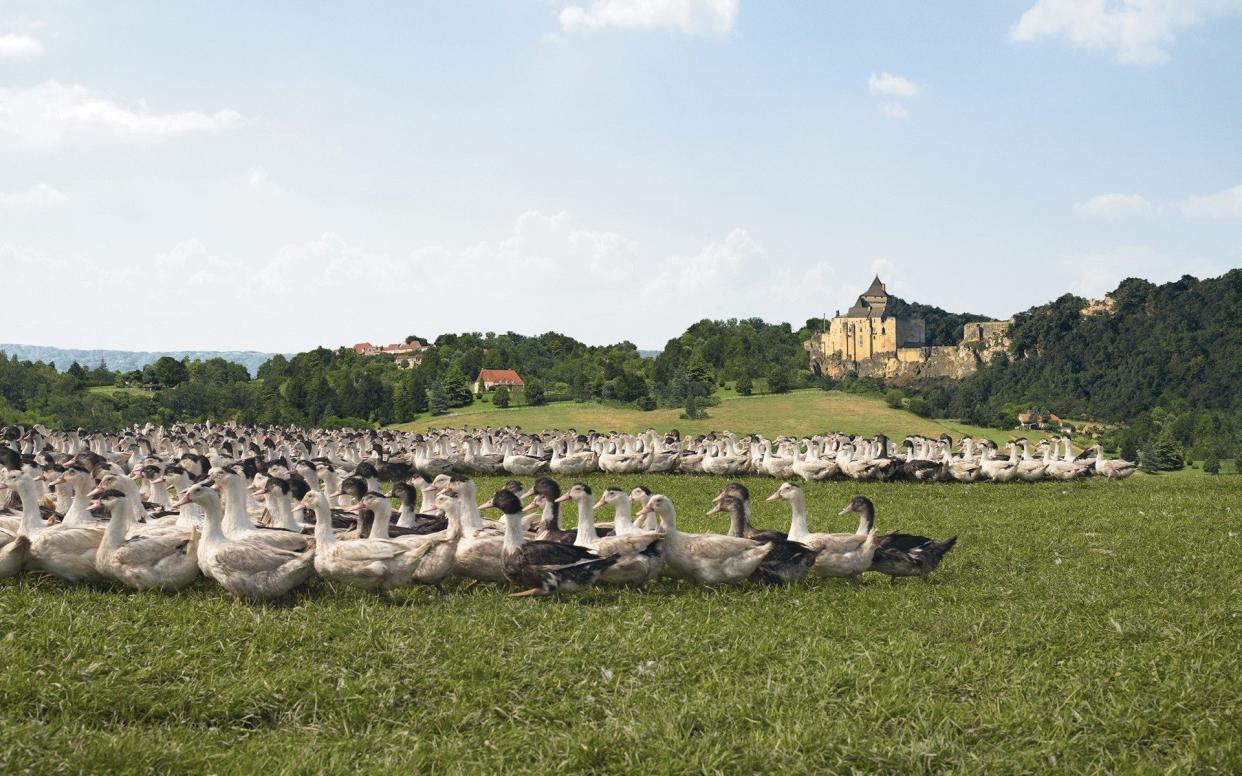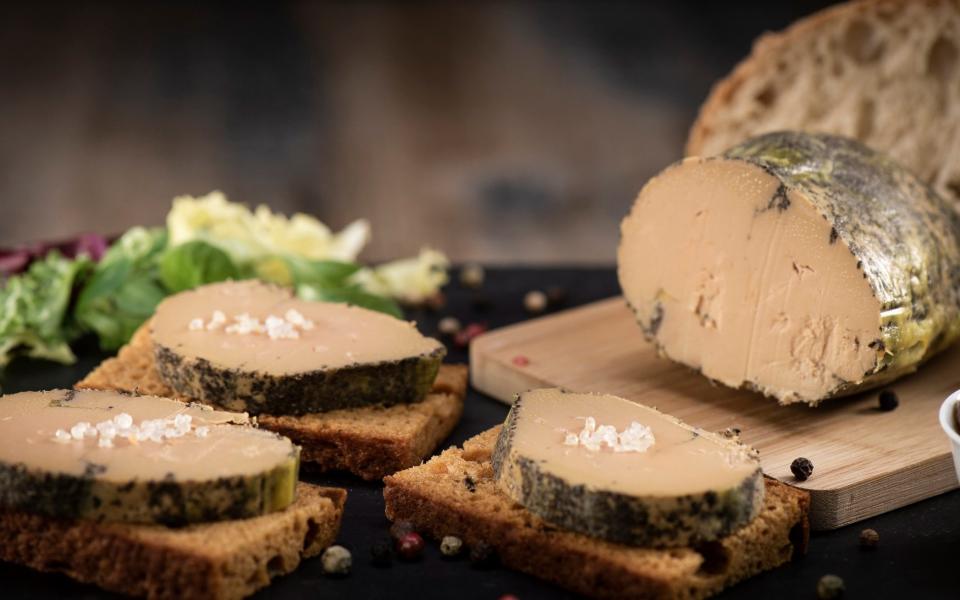In defence of foie gras

Originally published on September 26th
Many nutritionists recommend that we eat one portion of liver a week to get our dose of vitamin A and iron. And yet there is a variety of luxury offal that is increasingly off the menu: foie gras, the deliriously rich, densely calorific goose or duck liver with an image that is more superbad than superfood.
Full disclosure: I am a big fan of foie gras. I adore its rich taste and silky texture. I love it served as a savoury terrine contrasted with the sweetness of toasted brioche or crisped up with sticky pan-juices and meltingly soft within.
Few meat eaters deny that foie gras is deliciously decadent. But controversy surrounds its production, specifically the final 10 days of a bird's life, when it is force-fed to fatten up the liver to six times its natural size. As with any form of meat production, there are foie gras producers who raise the bird under atrocious conditions on an industrial scale. But I fail to see how eating foie gras in a restaurant such as Otto's on Gray's Inn Road, London, where the owner ensures the livers are from birds reared outdoors and fed by hand, is different from consuming any other ethically sourced meat.
The UK currently imports around 200 tonnes of foie gras a year but polls suggest the British public is overwhelmingly in favour of an outright ban, following similar legislation in California and New York.
Yet this form of food preparation is as old as Western civilisation. The force-feeding of ducks and geese dates back to 2500 BC: ancient Egyptian tomb carvings depict birds being fattened up by hand for the royal table. The Romans refined the technique by force-feeding geese with figs before swelling the liver further in a bath of milk and honey. The resulting delicacy was known as iecur ficatum - 'fig-stuffed liver' - which is why the Italian word for liver is 'fegato', or 'foie' in French.

Foie gras consumption declined with the fall of the Roman Empire until Medieval Jewish communities of central Europe discovered that force-feeding geese to make poultry fat (lard being non-kosher) produced a fatty liver as delicious as the extra lashings of goose fat (or schmaltz, to use the Yiddish word).
But it is French cuisine that is synonymous with foie gras. Not only have our Gallic neighbours developed the more sonorous terms of foie gras and gavage for 'fatty liver' and 'force-feeding', but the French Code Rural, or book of law, states, 'Foie gras is part of the protected cultural and gastronomical heritage of France.'
'The first references to eating foie gras in France come shortly before the French Revolution,' says historian Giles MacDonogh, whose books include studies of the legendary 18th-century gourmands Grimod de la Reynière and Brillat-Savarin. MacDonogh cites Jean-Pierre Clause as the foodie who first made foie gras famous. The Strasbourg chef created a dish of whole foie gras baked in pastry for the governor of Alsace, who was so delighted with it he sent a sample to Louis XVI at Versailles. 'By the dawn of the revolution, foie gras was being shipped from Strasbourg to the capital in clay containers,' MacDonogh says. 'There were virtually no restaurants in Paris. Instead, all the good cooking took place in the houses of the nobility, who exhibited their high status through the quality of their chefs.'
Come the revolution, all those newly unemployed cooks were opening restaurants to feed the emerging bourgeoisie. 'The new money was spending a fortune on anything delicious,' MacDonogh says. 'These terrines from Alsace first achieved importance when the middle classes heard about a fantastic food that had arrived in Paris, which they could try for the first time.'

Livers from the geese of German-influenced Alsace remained the most popular form of foie gras until the First World War. Duck farming, centred on south-west French regions such as Périgord and Gers, has traditionally come more naturally to the French, and 90 per cent of foie gras produced today is made from duck liver.
Age-old process
Chef Pierre Koffmann grew up in Gascony before moving to London and winning three Michelin stars at La Tante Claire in Chelsea, where he trained Marco Pierre White, Gordon Ramsay and Marcus Wareing. Koffmann says he learnt to cook during school holidays staying on his grandparents' farm in Gers, where his grandmother kept ducks to sell foie gras at Christmas.
Twice a day, Koffmann's grandmother fed her ducks maize boiled with a touch of black pepper, which added an extra flavour to the liver. The process is hardly changed today, except a machine administers the feed to each duck in a little over five seconds. For the 90 days before gavage starts, the ducks are fed normally and are free to roam around the farm. Once slaughtered, the rest of the bird is turned into south-western specialities such as confit de canard and cassoulet.
'Those people who complain about foie gras should first look at how chicken and pigs are bred in their own country,' Koffmann says. 'They like to criticise foie gras because it's French. You have to take a lot of care when you make foie gras. You must feed the duck very gently; if you hurt it and it dies you will lose your money.'
Koffmann retired from restaurants in 2016 and these days supplies the hospitality trade with superior British potatoes. With no diners to worry about offending, he is one of the rare chefs happy to talk about the hottest potato of all: a love of foie gras. An omertà exists in the world of fine-dining about publicly discussing foie gras, even though, as Koffmann says, 'a lot of chefs think that if you put expensive ingredients like foie gras on the menu, Michelin will give a star.'
Gwendal Poullennec, international director of the Michelin Guide, was unavailable to comment for this article, as were a pair of French chefs with two- and three-Michelin-starred outposts in London. Many London fine-dining restaurants serving foie gras do not list it on the menus on their websites.
Koffmann says no one complained about seeing foie gras on the menu of La Tante Claire, which he closed after 27 years in 2004; by the time he hosted a pop-up 10 years later, PETA protesters were camped outside dressed as ducks. 'So we removed foie gras from the printed menu and proposed it as a special of the day,' he says. 'We sold even more.'
Anti-foie activism
The animal rights group Direct Action Everywhere stormed the dining room of The Square in Mayfair in 2019 protesting against its use of foie gras; chef Clément Leroy responded by confronting the vegan activists with a brace of dead ducks before they headed off to cause more trouble at Fortnum & Mason, where the delicacy was then still sold. Otto Tepasse, the German-born owner of Otto's restaurant in Clerkenwell, refused to surrender when London Vegan Actions stationed 50 megaphone-wielding protestors Actions the restaurant for five months in 2016.
Others have taken a different approach. Midsummer House in Cambridge endured six months of protest from the Animal Liberation Front and £12,000 in damage before its chef, Daniel Clifford, stopped serving foie gras in 2008; the two-Michelin-starred Clifford has since said that removing foie gras from the menu opened his eyes to the potential of humbler ingredients.
Avignon-born chef Alexis Gauthier was trained in the fine-dining French tradition and won a Michelin star at Roussillon in Belgravia. When animal rights protesters camped outside his solo restaurant Gauthier Soho in 2013, however, the experience not only led to him taking foie gras off the menu but turning himself and the restaurant vegan. But still, 'if you want to be recognised as a wonderful French chef you have to master the art of foie gras,' Gauthier says. 'I used to sell kilos of pan-fried foie gras with roasted apple and port jus reduction. It's the best combination in the world. But I listened to what the protesters had to say and they opened my eyes to the atrocity of making foie gras. It is the only luxury product which involves force-feeding.'
Gauthier instead serves a vegan 'faux gras' made from lentils, walnuts and Cognac but suggests chicken livers as a carnivorous alternative - although he recently tried a cell-based lab-grown version in development from Parisian start-up Gourmey, which he says is 'unbelievably similar to foie gras'.

Fine-dining French restaurants in the UK are looking increasingly isolated in their use of foie gras. Pierre Gagnaire's three-Michelin-starred Sketch Lecture Room & Library combines duck foie gras with Sauternes jelly and Dorset crab, while the tasting menu at Pascal Aussignac's one-star Club Gascon features a course of duck foie gras 'Catalane' with barbecued corn and rocket. But there's no foie gras on the menu at Jason Atherton's one-star Pollen Street Social (although he doesn't rule out ever using it), while the signature dish of 'meat fruit' at two-star Dinner by Heston Blumenthal is now made with chicken liver rather than foie gras.
'I want to support British farmers,' says James Lowe, whose Michelin-starred Shoreditch restaurant Lyle's was ranked number 33 on 2021's World's 50 Best Restaurants list. 'If I were to do a foie gras dish, that's money that I'm not giving to a British farmer. I could do an amazing fatty pork dish instead.'
But Lowe's menu isn't governed solely by buying British. 'There was a time when every fancy restaurant would do foie gras because French food dominated the higher end of London dining. But there's been a shifting perception of what luxury is. We serve peas that were picked at three in the morning and then couriered to London. That's a rarer find than foie gras.'
The gastronomic divide is evident throughout the Anglosphere. The state of California has banned the production and sale of foie gras since 2012 while legislation banning the sale of foie gras in New York City is due to take effect this November. Australia forbids the production of foie gras, but not its import. Likewise, it has been a criminal offence to produce foie gras in the UK since 2006 and although the Animals Abroad Bill, which would have banned imports, was dropped in February amid cabinet opposition, animal welfare minister Zac Goldsmith intends to introduce individual reforms in future parliamentary sessions.
'The force-feeding of geese and ducks is indescribably cruel and is rightly already banned in the UK, but the trade flourishes elsewhere,' Goldsmith says. 'We are committed to taking strong and decisive action to better protect animals around the world and continue to explore further steps that could be taken in relation to foie gras, which raises serious welfare concerns.'
Jacob Rees-Mogg was reportedly among the cabinet members opposing the ban on the grounds that it infringed on personal choice. And yet a de facto ban already operates in London. While one can still buy tins of duck and goose foie gras (with or without truffles) in Harrods, Fortnum & Mason quietly stopped selling foie gras in November 2020. The Queen's grocer instead stocks Foie Royale, made in Germany from the livers of free-range birds raised for their meat and not force-fed.

I tried both Foie Royale duck and goose liver (£35.95 and £39.95 for 180g) from Fortnum's. Each pinky-grey foie looks the part, packaged in a Kilner jar under a layer of pearly fat, but only the goose - subtly flavoured and still firmly textured at room temperature - compared to the lusciousness of the real thing; served on a slice of toasted brioche, it would take the most refined palate to notice the difference.
In any case, foie gras is best prepared, as the French aristocracy appreciated, by someone who knows what they're doing, which nowadays means a restaurant chef. 'I've never tasted foie gras from a shop that was worth buying,' says Richard Corrigan, the chef and owner of Corrigan's Mayfair, where the grouse and foie gras pie is a highlight of the autumn calendar. 'Foie gras needs to be prepared from scratch. Marinade the lobes of liver with vintage port or sweet sherry and a seasoning of salt and pepper and foie gras becomes the most unctuous, delicious thing I've ever tasted, like eating a slab of butter. Foie gras is a completely unique product and it would be an amazing shame if it were banned from our tables for whatever goody-two-shoes reason.'
An outbreak of avian flu that has led to the slaughter of much of south-west France's duck population means foie gras is in short supply in the run-up to Christmas - which is perhaps the way it should be. 'Foie gras is a luxury,' Koffmann says. 'Traditionally in France it would only be eaten at big occasions such as a christening or wedding. Foie gras is like caviar or truffles - not something you eat every day.' Once a week, maybe.

 Yahoo Movies
Yahoo Movies 
